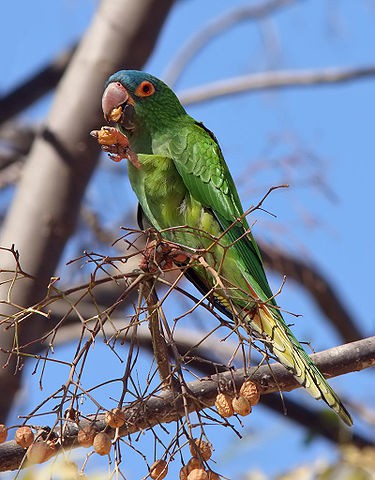Type the name of the breed you're looking for below
[wpdreams_ajaxsearchlite] Don't see the breed your're looking for? Click here and let us know!
Blue Crowned Conure
| Origin | The Blue-Crowned Parakeet, Blue-Crowned Conure, or Sharp-Tailed Conure is a small green Neotropical parrot with a blue head and pale beak native to large parts of South America, from eastern Colombia in the north to northern Argentina in the south. |
| Size | Can grow up to 14 in(35 cm) |
| Lifespan | Can live 15+ years |
| Noise | High |
| Characteristics | Blue-crowns are born with red colouring around the head, but blue-crowns are predominantly green, with dull blue colouring on the forehead, crown, cheeks, and ears in the nominate, but less blue in other subspecies. It has a ring of white featherless skin around each eye, though this is bright orange-yellow in wild. The breast feathers may also be tinged with blue, though they are more commonly green to yellow-green. Closed wing colouring matches that of the body while extended wings show blue-brown, becoming chestnut on the outer flight feathers. The tail feathers are green on top, maroon to red-brown on the underside, iridescent to bright orange and scarlet under full-spectrum light. Legs are pink-brown with grey-brown claws. The upper mandible is horn-coloured, tapering to a needle-sharp, grey-black tip. |
| Abilities | Can be taught to mimic human speech. Some species can learn up to 500 words. |
| Interaction/Time Requirements, Diet, Supplies Needed | Parrots are escape artists, be sure to secure the cage or aviary. Aviaries are sold ready for home assembly. Parrots do well in aviaries and cages. They don't like to be in crowded spaces and will sometimes be aggressive towards other birds if they don't have enough space. Parrots can also be hand reared, provided that they have a large cage and are taken out of their cage on a daily basis to prevent boredom, as it may result in the parrot pulling out its feathers to occupy itself. They require a warm habitat for the winter months. Do not allow your birds outdoors until all signs of frost are gone. Space is important and indoor cages should be as large as possible. A large cage is required even if the bird is going to spend lots of time out of its habitat with you. They eat a foreign seed mixture that contains various millets and other small seeds such as niger. You need to change food and water twice daily, and clean the cage at least once a day, replacing toys and broken climbing branches. |



